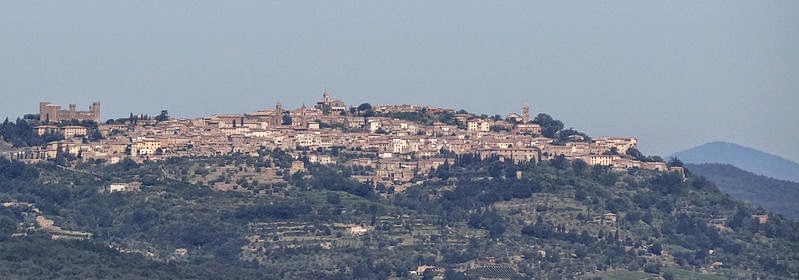view of montalcino
Executive summary by darmansjah
Montalcino is a hill town and comune in Tuscany, Italy. It
is famous for its Brunello di Montalcino wine.
The town is located to the west of Pienza, close to the
Crete Senesi in Val d'Orcia. It is 42 kilometres (26 mi) from Siena, 110
kilometres (68 mi) from Florence and 150 kilometres (93 mi) from Pisa. The
Monte Amiata is located nearby.
Main Sights
fortress in Montalcino
The first medieval walls were built in the 13th century. The
fortress was built at the highest point of the town in 1361, on a pentagonal
plan designed by the Sienese architects Mino Foresi and Domenico di Feo. The
fortress incorporates some of the pre-existing southern walls, the pre-existing
structures including the keep of Santo Martini, the San Giovanni tower and an
ancient basilica which now serves as the fortress chapel. Though the town
itself was eventually conquered, the fortress itself was never taken, an
admirable feat, considering the size of the Sienese and Florentine forces that
besieged Montalcino at varying intervals.
view from the fortress
Down the narrow, short street that extends from the main
gate of the fortress is the Chiesa di Sant'Agostino with its simple Romanesque
façade, also built in the 13th century.
Abbey st antimo
The building adjacent to the church is a one-time convent,
but it is now the home of the Musei Riuniti which is both a civic and diocesan
museum. The museums hold various works, including a wooden crucifix by an
unknown artist of the Sienese school, two beautiful 15th century wooden
sculptures, including one of an incredibly moving Madonna by an anonymous
artist which has become the symbol of Montalcino on the various posters and
publicity, and several other sculptures in terracotta which appear to be of the
Della Robbia school. The collection also includes a St Peter and St Paul by
Ambrogio Lorenzetti and a Virgin and Child by Simone Martini. There are also
more modern works from the beginning of the 20th century that offset and
reflect the older works of art in the artful way they are presented by the
curator.
The Duomo (cathedral), dedicated to San Salvatore, was
originally built in the 14th Century, but it now has a neo-classical appearance
thanks to extensive renovation work done in the early 19th century under the
direction of Sienese architect Agostino Fantasici.
Originally the Piazza della Principessa Margherita is down
the hill from the fortress and Duomo on the via Matteotti. The principal
building on the piazza is the town hall, once the Palazzo dei Priori (built
late 13th, early 14th century) which was for many years the Palazzo Comunale.
The palace is adorned with the coats of arms of the Podesta, once rulers of the
city. A very tall medieval tower is incorporated into the palazzo. Close by is
a Renaissance structure with six round arches, called La Loggia, which was
started at the very end of the 14th century and finished in the early 15th, but
which has undergone much restoration work over the subsequent centuries.
Montalcino is divided, like most medieval Tuscan cities,
into quarters called contrade, Borghetto, Travaglio, Pianello and Ruga, each
with their own colours, songs and separate drum rhythms to distinguish them.
Twice a year they meet together in a breath taking archery contest under the
walls of the Fortezza, conducted in Medieval dress, with lords and ladies of
each contrada who accompany the proceedings.
The 13th century church of San Francesco in the
Castlevecchio contrada has undergone several renovations. Some of the interior
frescoes were done by Vincenzo Tamagni in the early sixteenth century.
There are many other medieval buildings in Montalcino that
make up its centro storico (historical center). As with many other similar
cities, money from tourism is aiding the cause of restoration and preservation.
In 2010, the Festa Europea Della Musica had its first
edition in Montalcino, to underscore and promote the beauty and culture of the
town, and develop the artistic presence in the territorio as an
"abbinamento" to the immense quality of its wines and way of life.
Associated with the Fête de la Musique, created by Jack Lang in Paris in 1981 to
celebrate music and musicians, the Festa was incorporated into the Italian
Minister of Culture's agenda in 1994, and has since spread across Italy as well
as the world, encouraging the cooperation and musical exchanges between the
participating cities. Celebrated on the 21st of June, the entire town and its
"frazioni" become one varicoloured musical tapestry that offsets
beautifully the jewel of the territory itself.
Other sights
Churches with
frescoes of the Sienese School
the Rocca, a
ruined castle
Sant'Antimo, a
nearby Benedictine abbey
Paleontological
research into fossilised skeletons, notably a whale, at the wine estate
Castello Banfi (former name: Poggio alle Mura) in 2007.
See also
Brunello di
Montalcino
Val d'Orcia
commune montalcino





No comments:
Post a Comment